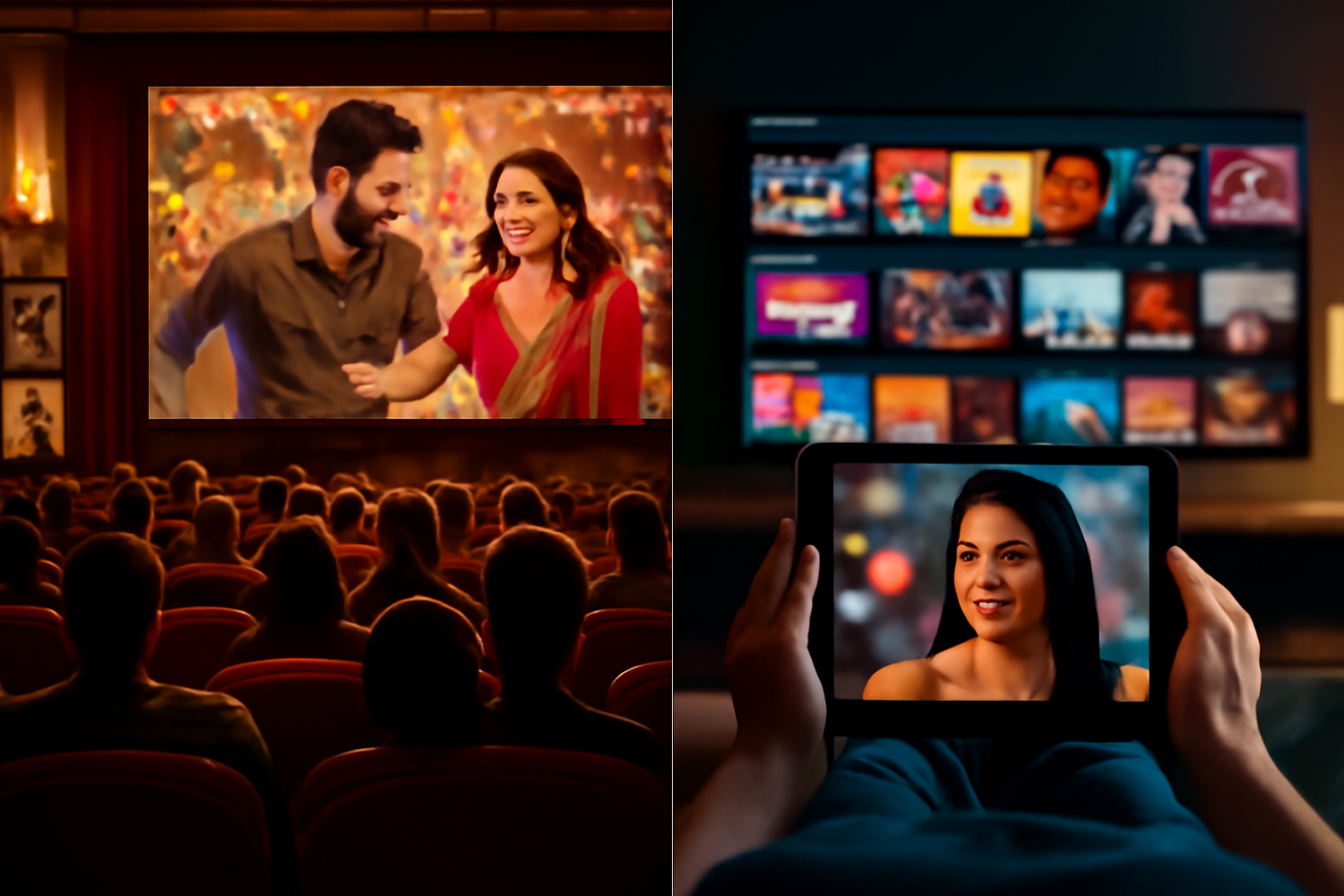Introduction
The Indian entertainment industry is undergoing a transformative revolution. With the rise of OTT (Over-the-Top) platforms like Netflix, Amazon Prime Video, Disney+ Hotstar, and ZEE5, traditional cinema — once the undisputed king — is facing both exciting opportunities and serious challenges. Especially in the world of Bollywood, this shift is redefining storytelling, production, distribution, and audience engagement.
In this blog, we dive deep into the impact of OTT on traditional cinema, analyzing the evolution, challenges, and future of both formats.
The Rise of OTT: Convenience Meets Customization
What is OTT?
OTT platforms are streaming services that deliver content via the internet, bypassing traditional cable or satellite providers. Audiences can now watch what they want, when they want, and where they want — from smartphones to smart TVs.
Surge in Popularity
The Indian OTT market has witnessed explosive growth, especially post-COVID-19. According to PwC, the Indian OTT sector is set to become the sixth-largest in the world by 2026, with a projected market size of over ₹11,000 crore. Lockdowns fueled a surge in OTT subscriptions, and that momentum hasn’t slowed.
Bollywood’s Changing Landscape
1. Shift in Storytelling
OTT platforms have empowered filmmakers to explore bolder, more diverse themes that may not pass traditional cinema’s commercial litmus test. Films like Guilty, Darlings, and Bulbbul showcase strong female leads and dark themes — once a rarity in mainstream Bollywood.
Shorter seasons, anthology formats, and experimental genres have made room for content that is richer and more niche.
2. New Faces, Fresh Talent
Gone are the days when star power alone guaranteed box-office success. OTT has democratized the industry. Talented newcomers and theater actors — such as Jaideep Ahlawat (Paatal Lok) and Shweta Tripathi (Mirzapur) — have become household names.
3. Theatrical vs. Digital Releases
Several big-ticket films — like Gulabo Sitabo and Shershaah — skipped theaters and premiered on OTT platforms. While producers benefited from upfront deals, it raised concerns among theater owners and distributors.
Challenges Faced by Traditional Cinema
1. Declining Footfall in Theaters
The charm of going to the movies is fading, especially for mid-budget films. While mega-blockbusters like Pathaan and RRR still draw crowds, smaller films often struggle to find an audience amidst streaming competition.
2. High Costs vs. Low Returns
Theatrical releases involve massive marketing and distribution costs. In contrast, OTT platforms offer guaranteed revenue through licensing, making them more appealing for producers of smaller films.
3. Audience Behavior Has Shifted
Today’s audience values convenience. The ability to pause, rewind, or binge-watch content on demand makes OTT platforms more attractive, particularly to younger viewers and working professionals.
The OTT Advantage: What Makes Streaming Irresistible?
- Personalization: OTT algorithms recommend content tailored to individual tastes.
- Affordability: Monthly subscriptions are cheaper than regular movie outings for families.
- Accessibility: Viewers from Tier 2 and Tier 3 cities can enjoy quality content without local theaters.
- Multi-language Content: Subtitles and dubs make regional and international shows accessible to a wider audience.
Can OTT and Traditional Cinema Coexist?
Absolutely — but with adaptations.
1. Hybrid Release Models
Some films are now experimenting with a 30-day window between theatrical release and OTT premiere. This hybrid approach maximizes both box office revenue and streaming rights.
2. Premium Movie Experiences
Cinemas are enhancing the theatrical experience with luxury seating, immersive sound, and gourmet food options to compete with home viewing.
3. Collaborative Content
Major production houses like Dharma Productions and YRF have inked multi-film deals with OTT platforms. Instead of viewing streaming services as competitors, Bollywood is learning to collaborate.
The Road Ahead: What to Expect
- More Direct-to-Digital Films: Mid-budget films will increasingly choose OTT first.
- OTT Original Series Boom: Expect more long-form storytelling with cinematic production values.
- Data-Driven Decisions: Viewer analytics will guide what gets made and how.
- Niche Genres and Global Stories: As audiences fragment, expect content that caters to specific tastes and transcends borders.
Final Thoughts
The rise of OTT platforms is not the end of traditional cinema — it’s a transformation. Bollywood, with its rich legacy and adaptive spirit, is poised to evolve alongside digital storytelling. Rather than a battle, it’s a blend — and in that fusion lies the future of Indian entertainment.
#OTTvsCinema #BollywoodStreaming #IndianCinema2025 #OTTIndia #NetflixBollywood #AmazonPrimeIndia #DigitalRevolutionCinema #MovieTrendsIndia #CinemaVsStreaming #BollywoodBuzz #FilmIndustryNews #StreamingImpact #CinephileCulture #HindiMoviesOnline #FutureOfBollywood #anslation #carrerbook #bloghub
⚠️ Disclaimer
This blog is intended for informational and educational purposes only. The views expressed are personal opinions or general insights, not professional or legal advice. Readers should do their own research or consult relevant professionals before taking action based on this content.


Leave a Reply